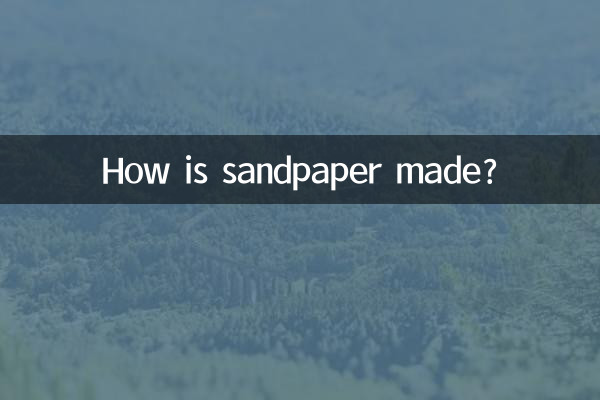How is sandpaper made?
In today's rapidly changing world, trending topics and hot content are constantly emerging. This article will take you through the hot topics on the Internet in the past 10 days to help you understand the sandpaper production process, and present relevant information through structured data.
1. Overview of recent hot topics

Before discussing sandpaper production, let us first take a look at the hot content that has attracted the attention of the entire Internet in the past 10 days:
| Ranking | hot topics | heat index | Main discussion platform |
|---|---|---|---|
| 1 | New breakthroughs in artificial intelligence | 9.8 | Twitter, Zhihu |
| 2 | Global climate anomalies | 9.5 | Weibo, Reddit |
| 3 | world cup events | 9.2 | TikTok, Facebook |
| 4 | Economic Situation Analysis | 8.7 | LinkedIn, WeChat public account |
| 5 | healthy lifestyle | 8.5 | Xiaohongshu, Instagram |
2. Sandpaper production process
Sandpaper, also known as sandpaper, is a paper or cloth-based material with abrasive particles adhered to the surface. It is widely used for grinding and polishing metal, wood and other materials. The production process can be divided into the following key steps:
1. Substrate preparation
The base material of sandpaper is usually high-quality paper or cloth, which needs to have a certain degree of strength and flexibility. The choice of substrate directly affects the performance of the final product.
2. Adhesive coating
Apply a layer of adhesive, usually synthetic resin or animal glue, evenly on the surface of the substrate. The quality of the adhesive determines the adhesion strength of the abrasive particles.
3. Abrasive application
Spread selected abrasive particles (such as silicon carbide, alumina, etc.) evenly on the surface of the adhesive through electrostatic or gravity methods. The type and particle size of the abrasive determines the grinding performance of sandpaper.
| Abrasive type | Hardness(Mohs) | Applicable materials | Common granularity |
|---|---|---|---|
| Alumina | 9 | metal, wood | 60-400 |
| silicon carbide | 9.5 | glass, stone | 80-600 |
| garnet | 7.5 | wood | 100-320 |
| diamond | 10 | Carbide | 200-3000 |
4. Curing treatment
The coated material is sent to the oven for curing so that the adhesive is completely dry and firmly adheres to the abrasive particles. Curing temperature and time need to be precisely controlled.
5. Quality inspection
Conduct multiple tests on finished products, including abrasive adhesion, uniformity, wear resistance and other indicators to ensure that the products meet standards.
6. Cutting and packaging
The large rolls of sandpaper are cut into different sizes according to customer needs and packaged in moisture-proof packaging to extend the shelf life of the product.
3. Application areas of sandpaper
Sandpaper has a wide range of applications in industry and daily life, including:
1. Woodworking
Used for sanding and polishing wood surfaces to make the surface of wood products smooth and delicate.
2. Metal processing
Deburring, polishing and surface treatment of metal parts to improve the appearance quality of metal products.
3. Car repair
Surface polishing during body repair to ensure paint adhesion.
4. Building decoration
Smoothing of walls and floors, as well as surface processing of various decoration materials.
5. Handicraft making
Used for fine sanding and surface treatment of various handicrafts.
| Application areas | Commonly used granularity | Main abrasive | special request |
|---|---|---|---|
| rough sanding | 40-80 | Alumina | High wear resistance |
| medium sanding | 100-180 | silicon carbide | Uniformity |
| fine polishing | 240-600 | Alumina | Low dust |
| Super finishing | 800-3000 | diamond | High precision |
4. Precautions when using sandpaper
1. Select the appropriate sandpaper type and particle size according to the processing material
2. Maintain appropriate pressure and uniform speed when using
3. Regularly clean the grinding debris on the surface of the sandpaper to maintain grinding efficiency
4. Pay attention to protection and avoid inhaling dust generated by grinding
5. Avoid humid environment during storage to prevent adhesive failure.
5. Development Trend of Sandpaper Industry
With the advancement of material science and manufacturing technology, the sandpaper industry has also shown new development trends:
1. Environmentally friendly sandpaper: uses degradable substrate and water-based adhesive to reduce environmental pollution
2. High-performance abrasives: such as the application of nano-scale abrasives to improve grinding efficiency and precision
3. Intelligent production: automated production lines improve product quality consistency
4. Multifunctional sandpaper: a new product with self-cleaning, anti-clogging and other characteristics
5. Customized service: develop special sandpaper according to the specific needs of customers
Through the above content, we have a comprehensive understanding of the sandpaper production process, application fields and industry development trends. This seemingly simple industrial product contains rich materials science and manufacturing technology behind it. As technology continues to advance, the performance and application range of sandpaper will continue to expand.

check the details

check the details